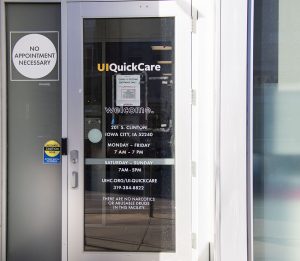From the COVID-19 unit: what Iowa health care workers want you to know
As frontline health care workers fight the spread of the coronavirus, they are experiencing stress and fatigue like they’ve never felt before. They’re asking for help to alleviate the stress of this virus.
Advanced Registered Nurse Practitioner (ARNP) Liz Highland twists the lid on a sippy cup at her home on Monday, Nov. 23, 2020. Highland works two twelve-hour shifts at the ILI Clinic per week and helps with telemedicine and administrative tasks throughout the week, adding up to 45 hours in a regular work week. On nights when she arrives home after her husband Corey and 18-month-old daughter Loah have gone to bed, Highland usually takes a shower, eats dinner, and does dishes, laundry, or other household tasks in a quiet house before bed. “It’s kind of sad to me, but [Corey] is a student also, so a lot of times even when I do come home we don’t have a lot of time to sit and chit-chat ‘cause he’s doing homework or like today he got up at 4:30, he’s got to get up at 4:30 again.” Highland said, adding that it works for childcare but she and her husband never see each other.
December 8, 2020
Kirstin Brainard called a patient’s loved ones to deliver the news that no one wants to hear. A medical intensive-care unit nurse at University of Iowa Hospitals and Clinics for a decade, Brainard has developed nonverbal signals to ease conversations about the end of a patient’s life. But, before the hospital began allowing strictly limited visitors, she’s had to start that conversation over the phone.
“This in my opinion has been the most exhausting part of COVID-19,” Brainard said. “It’s so very difficult to tell a wife that her husband will likely die during this hospitalization or telling someone that their loved one did in fact pass away.”
Brainard is one of hundreds of nurses at Iowa’s largest research hospital network that strap on gowns, masks, and gloves to face a virus which leaves some unscathed and others fighting for their lives.
UIHC is a destination for the sickest patients in Iowa and some surrounding states, and recently added 10 ICU beds to accommodate a November spike in hospitalizations. The stresses of a constant high workload and emotional toll caring for patients seeps into health care workers’ lives outside the hospital.
Since the start of the pandemic in March, frontline workers around the country, including at UIHC, have worked tirelessly to stop the spread of the infectious disease. As positive cases, hospitalizations, and deaths continue to rise, UIHC officials are preparing for the worst months of the pandemic, and health care workers are desperately asking people within their community to make changes to stop the spread.
Brainard tested positive — one of 1,200 UIHC workers to do so since March — for the coronavirus after her boyfriend, an ER nurse, contracted it at work, leaving her waylaid with a bad cold for a week and unable to come into work.
But, after seeing semi-compliance with mask-wearing at the grocery store, she said she feels more at risk there than at the PPE-laden hospital.
“People are kind of slipping a little bit, because they’re getting sick of it. I understand — so am I. It’s a little bit different because I also need to go to work to care for patients that are getting sick,” Olson said. “If I get sick, that’s one more nurse that can’t come into work or one more person that can’t care for a patient.”
Health care workers, like the rest of the population, have made significant changes to their routines during the pandemic. They also have to worry about protecting their family and friends every time they go to and from work.
Brainard hasn’t seen close friends for nearly a year, and said she leaves her shoes at work to avoid bringing any virus into her home.
With three children at home, UIHC staff and charge nurse Lillian Olson makes sure to wear her protective equipment and avoid close contact with patients when possible. While providing emotional support has always been her main objective, she opts to keep conversations short to avoid catching the infectious disease and spreading it to her family.
RELATED: University of Iowa hospitals and clinics do not have staff available to combat COVID-19 crisis
At the start of the pandemic, many health care workers, including Olson, feared for their lives while working inside the hospital. She was pregnant at the start of the pandemic, carrying her baby at work with her, and giving birth in the summer.
Now, Olson said she is more wary of conditions outside the hospital — where the virus thrives in mask-less gatherings.
“I felt safer being at work than I did in the community,” Olson said. “At work we hold each other accountable — making sure people are wearing the proper PPE.”
Health care workers are struggling with figuring out how to not feel isolated as they navigate this new COVID-19 reality.
Research from University of Turin in Italy published in October shows frontline health care workers have experienced rising rates of depression, increased anxiety, and burnout. The Iowa Hospital Association warned of impending burnout for health care workers because of the recent spikes on Nov. 24.
The number of Iowans in the hospital with COVID-19 topped 500 for the first time on Oct. 20, and spiked, reaching 1,500 three weeks later. Hospitalizations have since dropped slightly — the state reported 900 coronavirus patients in the hospital statewide Tuesday with 191 patients in intensive care units — but are still higher than the spring and summer months.
Iowa has confirmed 2,919 deaths since the pandemic began. November marked the deadliest month, with 611 deaths.
There isn’t much of an opportunity to escape the stress of the job, Brainard said. She tries to spend time with her significant other to relax. Before the pandemic, she would go out with her friends or eat at restaurants — which is not an option now.
“I often think the most difficult question for me to answer is ‘how are you feeling?’,” Brainard said. “And the reason is that I have so many emotions all at once and I don’t feel like I have the ability to explain them, so I just say ‘Tired.’ We are tired.”
Liz Highland, lead advanced practice provider for the Influenza-Like Illness Clinic at UIHC, has a one-year-old daughter and a husband who is a full-time student. She doesn’t have time to take breaks.
“An escape from all of the stress is not possible. My job has become increasingly stressful as our numbers have gone up in the last couple of weeks,” Highland said. “It sometimes feels like people don’t care about the pandemic anymore. That is tough.”
RELATED: UIHC CEO says its ready for surge capacity as COVID-19 hospitalizations climb
Iowans have begun to grow weary of the pandemic, Brainard said. According to the World Health Organization, people across the globe have been experiencing “pandemic fatigue,” or a feeling of demotivation when it comes to following safety protocols to avoid spreading COVID-19.
“The biggest thing to keep in mind for people who are still not convinced that this is a dangerous virus is that it’s not only the death rates that we’re concerned about, it’s that people are not returning to home normal,” Brainard said.
The sky-high numbers in November— with Iowa consistently in the top 10 states for COVID-19 spread — prompted UIHC to implement phase one of its surge plan.
The surge plan asked nurses to work if exposed to COVID-19, but asymptomatic, added ICU beds, and limited patient visiting hours, as previously reported by The Daily Iowan. UIHC is also taking fewer patients in the clinic, operating rooms, and some procedure areas to allow cross-trained hospital staff to take more shifts on COVID-19 floors.
According to UIHC as of Monday, the hospital has 56 adult inpatients and the positive symptomatic COVID-19 test results is 27 percent. More cases, especially in the 40-60 age range, often are a predictor for more hospitalizations.
Care for patients may last even after discharge from the hospital. Brainard cared for a patient who started with a cough, which then led to what was likely chronic lung disease.
“We have had several patients already get readmitted with lung damage that occurred early when they were actively infected with COVID-19, some may have lifelong issues of interstitial lung disease, some may need oxygen for the rest of their lives,” Brainard said.
Brainard said there’s no way for patients or health care providers to know who will need critical care. She said she’s seen patients young and old leave the hospital with similar conditions.
Harvard Research shows that about 36 percent of patients develop neurological symptoms after testing positive for the coronavirus. A study done in Wuhan, China, found that 19 percent of the 416 hospitalized COVID-19 patients showed signs of heart damage.
Those the DI interviewed empathize with people who are tired of the pandemic, but they’re asking people to hold out a bit longer for the vaccine — which is expected to be distributed to high-priority populations such as health care workers in mid-December.
Olson said it’s important to social distance, wear masks, practice hand hygiene, and avoid small gatherings. She said these measures have been proven to work — pointing to herself never contracting the virus as an example.
RELATED: UIHC CEO recommends rethinking holiday plans amid worst chapter of COVID-19 pandemic
Nicholas Mohr, a physician in the emergency department in the Intensive Care Unit at UIHC, said people in the community can stop the spread of the virus if they follow these guidelines.
“The decisions that we make as individuals have consequences. The way that we make those decisions influences case counts and hospitalization numbers — it influences deaths,” Mohr said. “The thing we have control over as members of the public, as Iowans, is how we can individually stop the spread of the infection.”



![Advanced Registered Nurse Practitioner (ARNP) Liz Highland twists the lid on a sippy cup at her home on Monday, Nov. 23, 2020. Highland works two twelve-hour shifts at the ILI Clinic per week and helps with telemedicine and administrative tasks throughout the week, adding up to 45 hours in a regular work week. On nights when she arrives home after her husband Corey and 18-month-old daughter Loah have gone to bed, Highland usually takes a shower, eats dinner, and does dishes, laundry, or other household tasks in a quiet house before bed. “It’s kind of sad to me, but [Corey] is a student also, so a lot of times even when I do come home we don’t have a lot of time to sit and chit-chat ‘cause he’s doing homework or like today he got up at 4:30, he’s got to get up at 4:30 again.” Highland said, adding that it works for childcare but she and her husband never see each other.](https://dailyiowan.com/wp-content/uploads/2020/12/Top-3-900x600.jpg)



